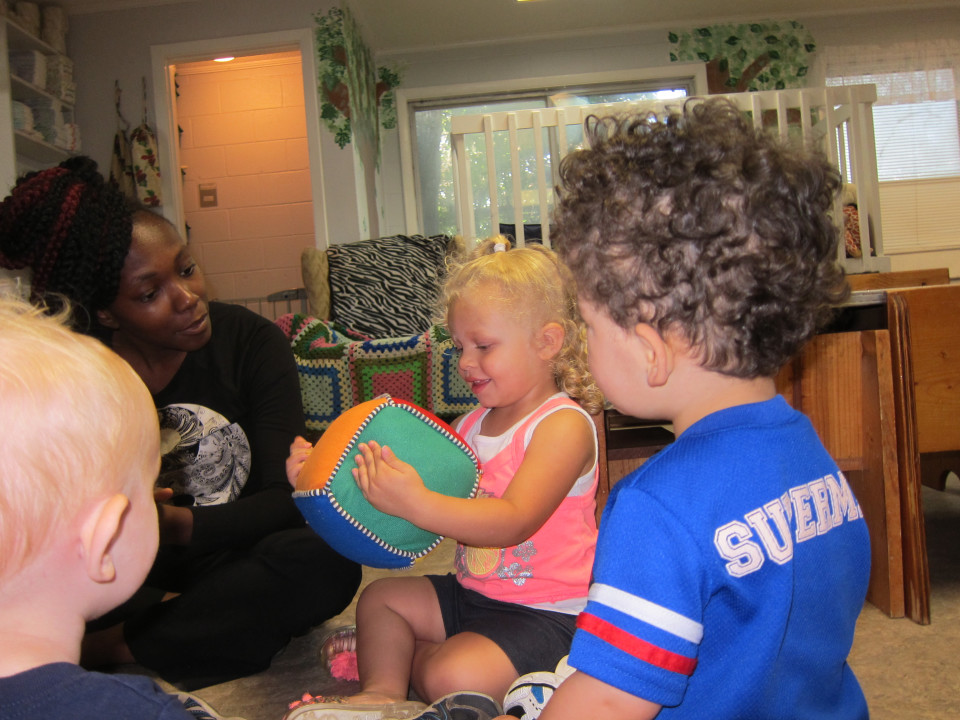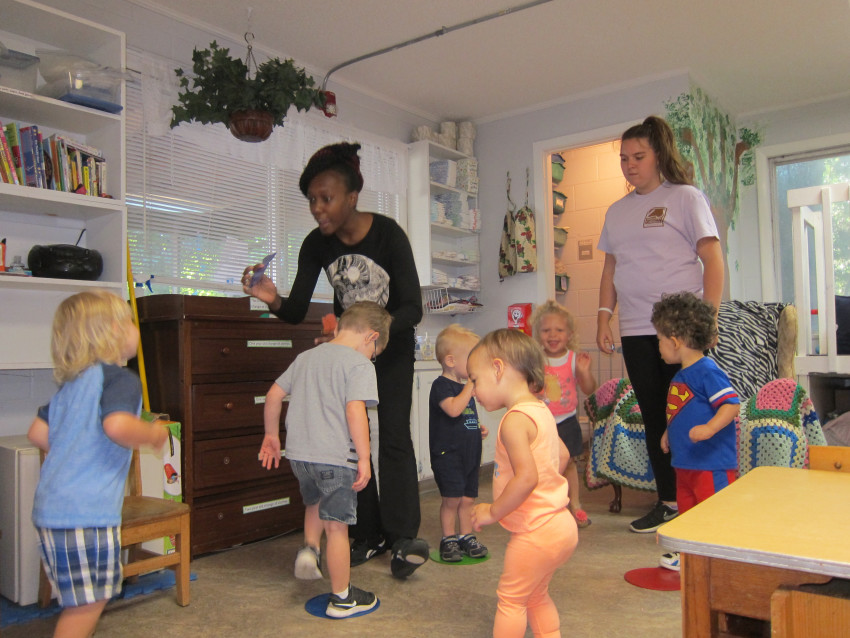How early education career academy is building students experience
- October 17, 2016
- / Shannon Nickinson
- / education

Thalezondra Hill-Dowdy and her students at Jamison Street Preschool in west Pensacola
engage in center-based, interactive learning throughout the day. Credit: Shannon Nickinson.
Not everyone can keep a classroom full of 2 and 3-year-olds engaged, but Thalezondra Hill-Dowdy can.
Hill-Dowdy keeps her young charges learning, but for all they know, they’re just having fun. From the color song they sing as they sit in a circle, passing a soft multicolored block among each other, to the scavenger hunt they have to find construction paper fish of a certain color, is surely fun.

Thalezondra Hill-Dowdy and her students at Jamison Street Preschool in west Pensacola engage in center-based, interactive learning throughout the day. Credit: Shannon Nickinson.
But she’s also teaching them their colors, how to sort like objects and how to take what they learn at Jamison Street Preschool and apply it to the world around them.
“I grew up around a lot of kids, watching kids,” she says. “Kids have always been a passion in my life.”
An early education career academy at Escambia High School helped her channel that passion into a career path. Hill-Dowdy, who graduated from Escambia High School last year, is a Pensacola State College student working on her associate’s degree with an eye toward elementary education.
It also allowed her work toward getting a national certification considered an important standard for quality in growing conversation around in early childhood education. Hill-Dowdy was one of seven students last year to earn their Child Development Associate credential, something that makes them valuable on the job market, and enhances their higher education goals.
Quality in early childhood education can help improve the kindergarten readiness of students in preschool programs. That's an issue for Escambia County, where the most recently released data from the Florida Office of Early Learning shows that only 66 percent of kindergartners in Escambia are ready for school.
Hill-Dowdy says the program gave her practical experience and a good foothold on her further goals.
“I like being able to know children a little bit better,” she says. “Some people have kids but they don’t exactly know the way children think. (This helped me) get the insight of knowing a child a little bit better.”
Research indicates that students in career academies are more likely to graduate from high school, and can see higher earning power and better career prospects upon graduation. That can be important for Escambia County, where the high school graduate rate is 72.7 percent.
The academy is a partnership between the Escambia School District and the Escambia Early Learning Coalition. The Coalition reimburses the district for the cost of the test, according to Vicki Pugh, program improvement director for the coalition.
“It is going to make the industry a better place,” Pugh says. “These kids are trailblazers in this perspective. The reason we first started doing this for that pipeline of bringing professional people in.”
Pugh helps identify childcare centers that will provide real-world experience to students as they progress through the academy.
“It’s been a good partnership for my folks as professionals,” Pugh says. “It reminds them why we’re here. It’s a great stepping stone to be a teacher, a pediatrician. The kids from these academies, they’re going to become advocates for early childhood. I like that.”
Grads of the program also can get up to nine credit hours at PSC if they go into a early childhood track at the college. The academy includes the participation of childcare centers where students can get real-world experience.
Kathy McCluskey, who teaches in the early childhood education academy at Booker T. Washington High School, says the Child Development Associate credential allows students to move up through the ranks when they choose to enter the workforce.
“It saves them money because we pay for that,” McCluskey says of the test, which costs $420 per students to administer and carry $95 worth of prep materials.
“I have students who want to work in daycare, students who want to be pediatricians, child psychologists, the whole gamut, who are in this class,” McCluskey says. “Some of my girls want to run their own childcare center some day.”
Autumn Dalesandro was another of the students to earn her CDA last year. Now she is working as a teacher’s assistant with Head Start at the Gibson Center on North C Street. Head Start and Community Action will help offset some of the cost as she pursues her degree.
“There was a lot of the stuff we had to do for the CDA,” she says. “The portfolio, that took so much time, end of course exams. It was a lot.”
Delasandro said the academy helped her realize that her love of working with children was something she wanted to make into a career. Even the children who come to her classroom with challenges.
“You can tell a big difference, a lot of the children don’t know their names when they walk in the door,” she says. “Some of the kids we have now can’t recognize a single color. I worked in a daycare for a good part of my senior year. Some of the children were challenging, but that motivates me to work with them.”
Aisha Adkison, workforce education specialist, said the academy is at Escambia, Pensacola, Washington and Tate high schools and includes 382 students in total. It includes instruction in child development with a focus in the birth to 5 time frame. It also includes clinical experience in childcare centers or in elementary school classrooms from grades K-2.
“A lot of these students take the step of going to get their higher education,” Adkison says. “Many go into elementary education and we can end up hiring them as teachers. We have this local pipeline we can build.”
In the freshman and sophomore years, students work toward the state certifications from the Florida Department of Children and Families that they would need to work in the field.
“It’s the beginning that process of let’s have a quality, more educated, more focused childcare staff,” Adkison says.
Under the supervision of teachers, they begin working in classrooms in an elementary school. They get experience working with kids with special needs. At Tate, Adkison says, they had a great relationship with Westgate, where students get experiences they might not have otherwise.
“We’re trying to produce a literate workforce from the word go,” Adkison says.” But I also want that high school student that we can train, so there’s more of us that get that 0 to 5 time frame is so critical.”
Students must complete a portfolio with critical pieces, Adkison says, including their philosophy on early childhood education, and an autobiography that explains why they want to do this. They are then observed by a third party at their job. They must pass an assessment at a testing center. They must understand why it’s important to involve parents in a child’s education, ‘just like you were a teacher writing a thesis,” she says.
The list of career pathways approved by the state is focused heavily on information technology, trades, healthcare careers, and STEM fields. For a while, Adkison said, they removed anything that related to early childhood education from that list.
“We spent several years making the case for if you want a literate workforce, you’ve got to give some equal weight that this is an important professions and career pathway. It needs to be on the (Career and Professional Education Act) funding list also.”
Analise Pierce worked as a protective service worker for the Department of Children and Families. She has been teaching at the PHS academy for five years.
“It’s extremely rewarding seeing them go from ninth graders to starting their careers,” Pierce says. “There’s nothing like doing a lesson plan and then implementing it with children and then sometimes they see what they should have done, how the students respond to it and what they say.”
One center director shared with Pierce that she say learning gains in her preschool students after they worked with the PHS students in Pierce’s program.
“She said that the learning gains were exceptional,” Pierce says.
Elijah Snell is a PHS grad now working at Marcus Point After School program as a teacher. He was drawn to the early childhood track by the experience his cousin had in the career academy program.
“I just loved it,” Snell says. “It’s a great feeling when I know that they need help and leading them into the right path.”
Now he wants to become something he didn’t see enough of in his own elementary school time — a male teacher.
“Have you ever thought about children learning in elementary or middle school?” he says. “Most of them don’t have males as role models, so why not take the step and you be the role model to show them men can be be teachers?”
 CivicCon launches with a look at good growth in cities
CivicCon launches with a look at good growth in cities
 Building stronger brains one baby, one parent at a time
Building stronger brains one baby, one parent at a time
 SCI debuts commercial on Early Learning City
SCI debuts commercial on Early Learning City
 Entrecon: World class speakers and an opportunity to sharpen skills
Entrecon: World class speakers and an opportunity to sharpen skills
 PYP Quality of Life survey 2017
PYP Quality of Life survey 2017
 EntreCon Pensacola 2016: A look back
EntreCon Pensacola 2016: A look back
 Leadership tip: getting better employee takeaways
Leadership tip: getting better employee takeaways
 Leadership tip: be interested instead of interesting
Leadership tip: be interested instead of interesting
 Leadership tip: delivering difficult messages
Leadership tip: delivering difficult messages
 Brain Bags boost Arc, Early Childhood Court programs
Brain Bags boost Arc, Early Childhood Court programs